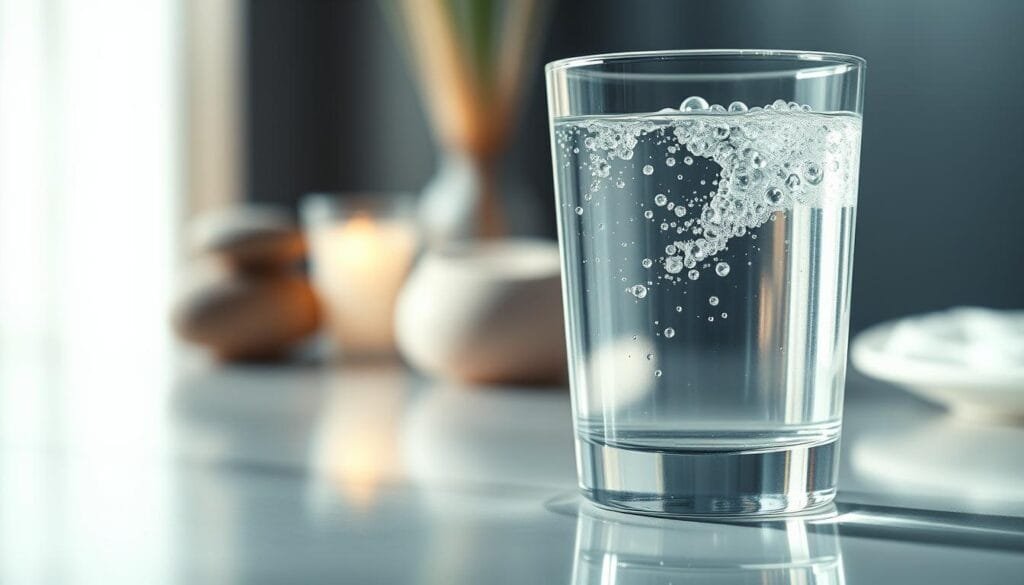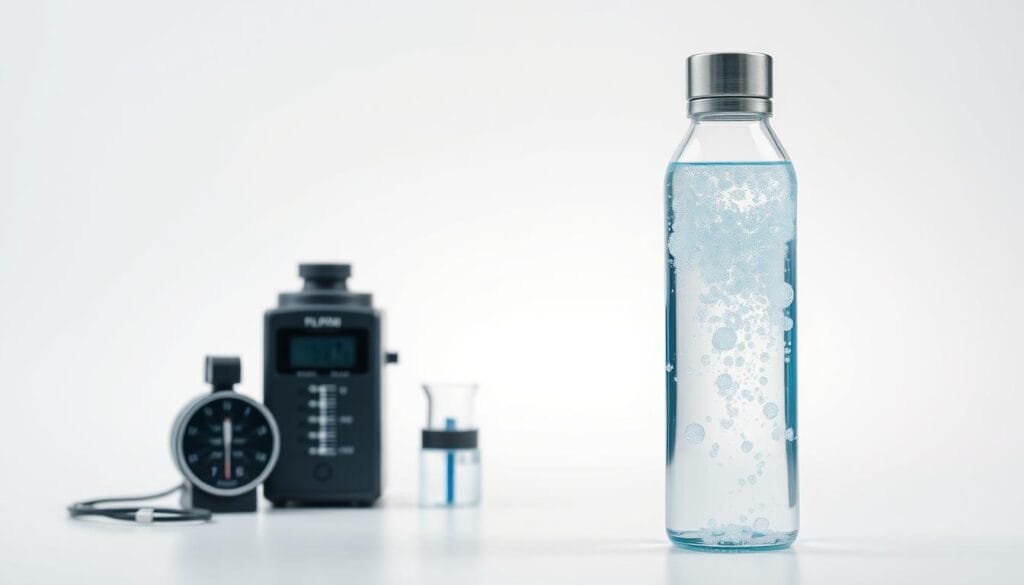Currently Empty: RM0.00
Could a tiny number in a label change how you feel after a drink? This question guides many Malaysians when they shop for bottled H2-rich drinks and portable systems.
Parts per million is a simple unit that shows dissolved molecular H2 in a litre. It helps readers compare products and spot true hydrogen concentration versus low lab results in stored goods.
The science points to benefits starting near 0.5 parts per million and rising up to around 4.0 or more depending on production and how soon one drinks it. Fresh-made H2 tends to keep more gas than stored options that fall to PPB levels.
Wellness Concept invites questions via WhatsApp at +60123822655. Business hours are Monday–Friday 9:30 am–6:30 pm and Saturday–Sunday 10 am–5 pm. They help consumers match ppm numbers to hydration, recovery, and wellness goals.
Key Takeaways
- Parts per million tells how much molecular H2 is dissolved per litre.
- Benefits may start near 0.5 ppm; higher concentration can boost effects.
- Fresh-made products retain more dissolved gas than stored ones.
- PPM is the practical unit for comparing consumer options.
- Contact Wellness Concept on WhatsApp +60123822655 for guidance.
Understanding PPM and PPB in hydrogen water today
A simple number on a label helps shoppers compare dissolved gas in each litre.
PPM explained: parts per million and dissolved gas
PPM shows milligrams of hydrogen per litre. It gives a clear view of molecular hydrogen present in a glass or bottle. Brands and devices use this to state hydrogen concentration so buyers can compare products easily.
PPB explained: parts per billion and low readings
PPB denotes micrograms per litre. Testers use it when levels fall very low, such as in stored samples that lost most dissolved gas. Reviewers often note PPB results as a sign of reduced potency.
Scale and conversions: simple math
- 1 PPM = 1 mg/L.
- 1 PPM = 1,000 PPB (micrograms/L).
- Consumers prefer PPM figures for practical potency and comparison.
For product questions or local advice, contact Wellness Concept on WhatsApp at +60123822655 during Monday–Friday 9:30 am–6:30 pm; Saturday–Sunday 10 am–5 pm.
Why hydrogen concentration matters for health and performance
Measured hydrogen concentration links the label number to likely effects on recovery and everyday function.
From antioxidant potential to reduced oxidative stress
Research suggests antioxidant action begins near 0.5 ppm. At that level, studies report signals of reduced oxidative stress and cellular protection when the drink is consumed fresh.
Higher concentrations often show stronger responses in lab markers. But timing matters: dissolved gas escapes quickly, so fresh intake preserves results.
Real-world benefits at higher concentration
Verified ppm aligns with practical benefits such as improved energy and perceived recovery after training.
Users report support for hydration routines, lower inflammation markers in some trials, and better cellular resilience when concentration is reproducible.
- Start point: benefits hydrogen water may appear around 0.5 ppm.
- Timing: consume shortly after generation to retain potency.
- Practical tip: target ranges that match activity—daily hydration vs athlete-level use.
For tailored guidance on energy and recovery goals, Malaysians can message Wellness Concept on WhatsApp at +60123822655 during business hours: Mon–Fri 9:30 am–6:30 pm and Sat–Sun 10 am–5 pm.
What does ppm mean for hydrogen water?
Labels use a simple ratio to tell how much dissolved gas sits in each litre.
PPM defines mass per volume: 1 ppm equals 1 mg of molecular hydrogen per litre. This metric quantifies dissolved hydrogen gas so consumers can compare concentration across bottles and devices.
Researchers and product guides rely on ppm to set realistic expectations. A measured figure shows how much gas is in solution at the moment of testing, not just the device’s maximum output.
Molecular hydrogen is tiny and escapes quickly. Delays between generation and drinking lower levels, so timing matters when aligning real use with research-backed outcomes.
Practical takeaway: check ppm after a cycle, sip promptly, and use titration drops or a digital display to verify readings. For demos or local advice in Malaysia, readers can message Wellness Concept on WhatsApp at +60123822655 during business hours.
Therapeutic ranges and typical product levels at present
Practical ranges help shoppers match product labels to personal wellness and training needs.

Daily wellness range
Aim for about 0.5–2.0 ppm as a practical band for consistent support. This range often gives steady benefits when water is drunk soon after generation.
Higher concentrations for athletes
For elevated oxidative stress or intense training, target 2.0–4.0+ ppm. Higher concentrations may boost short-term results, but timing and intake matter most.
Fresh-made versus stored
Stored bottles can fall to 100–500 ppb, which signals reduced effectiveness. Fresh-made drinks keep more gas and deliver better benefits hydrogen users expect.
| Product type | Typical levels | Notes |
|---|---|---|
| Store-bought hydrogen-rich water | 0.3–0.8 ppm | Convenient, lower stability |
| Low-end bottles | 0.5–1.0 ppm | Entry-level performance |
| High-end PEM bottles | 2.0–3.5 ppm | Better stability and results |
| Effervescent tablets (fresh) | 8–10 ppm (brief) | Very high but short-lived gas |
Technology and build quality shape achievable concentration and stability. Malaysians can ask Wellness Concept on WhatsApp +60123822655 to compare products and set realistic ppm targets during business hours.
How to measure, verify, and preserve effective PPM
Accurate measurement and careful handling protect the gas that delivers benefits in each glass.
Testing tools and quick checks
Titration kits give a hands-on ppm hydrogen reading by counting drops until the endpoint. Electronic testers and some premium bottles show a real-time display during electrolysis.
Users should test the actual bottle or glass they will drink from, not only device specs. This verifies real-world effectiveness and hydrogen concentration before use.
Best practices to preserve gas
- Drink promptly after generation and keep lids sealed to reduce escape.
- Avoid shaking and warm temperatures; chilled water holds gas longer.
- Choose proven PEM technology and sturdy bottles to improve consistency.
“Minimize agitation and verify concentration in the drinking vessel to match results with hydration and effects,” advises many lab guides.
| Method | Typical result | Notes |
|---|---|---|
| Titration kit | 0.1–5.0 ppm (varies) | Affordable; needs careful technique |
| Electronic tester | 0.2–4.0 ppm | Fast readout; portable |
| Built-in bottle display | Real-time during cycle | Best for confirming immediate use |
For a quick ppm check or demo, message Wellness Concept on WhatsApp +60123822655 within Monday–Friday 9:30 am–6:30 pm; Saturday–Sunday 10 am–5 pm.
Choosing a hydrogen water bottle in Malaysia: quality, PPM targets, and support
Smart buyers focus on verified readings, build quality, and service when choosing a hydrogen water bottle.
Start with realistic ppm targets. High-end PEM bottles commonly reach 2.0–3.5 ppm when used correctly. Some brands claim higher output, but immediate consumption and verification are essential to get consistent results.
Compare technology and build. Choose bottles with proven PEM systems, robust seals, and simple cleaning. Poorly stored products or flimsy bottles often lose gas and underdeliver.

Quick checklist to evaluate a water bottle
- Look for ppm verification or a demo readout.
- Check build quality, capacity, and spare parts availability.
- Confirm local warranty and simple maintenance tailored to needs.
- Prefer transparent testing or third-party readings over bold specs.
Local support matters. Malaysians benefit from nearby service, parts, and advice that keep bottles performing and extend lifespan. Request demonstrations, ask about expected levels, and plan for routine checks to protect energy and hydration goals.
“Request ppm demonstrations or third-party readings rather than relying solely on specs.”
Contact for guidance
Message Wellness Concept on WhatsApp at +60123822655. Business hours: Monday–Friday 9:30 am–6:30 pm; Saturday–Sunday 10 am–5 pm. They help match bottles and technology to budget, range, and daily wellness needs.
Conclusion
In short, clear measurement helps turn product claims into repeatable everyday benefits.
PPM is the practical way to read dissolved gas and match expected results. Benefits often begin near 0.5 ppm, and higher levels can boost energy, support hydration, and reduce oxidative stress when drinks are consumed promptly.
Choose products and technology that show verified hydrogen concentration, solid build quality, and easy checks to protect effectiveness. Small actions—testing, sealing lids, and quick use—unlock steadier health benefits and better results.
Malaysians can message Wellness Concept on WhatsApp at +60123822655. Business hours: Monday–Friday 9:30 am–6:30 pm; Saturday–Sunday 10 am–5 pm.
FAQ
What is parts per million in relation to hydrogen-rich water?
It refers to how many molecules of molecular hydrogen exist in one million parts of liquid. Higher values indicate a stronger dissolved gas concentration, which generally means a greater potential for antioxidant effects and biological signaling.
How do parts per billion compare to parts per million?
Parts per billion is one thousand times smaller than parts per million. Lab tests use PPB when concentrations fall below the PPM range; 1 PPM equals 1,000 PPB, so PPB readings often show loss of potency in stored bottles.
Why is concentration important for health and performance?
Stronger concentrations can deliver more molecular hydrogen to cells, which research links to reduced oxidative stress, improved recovery, and lower inflammation. Benefits depend on dose, timing, and individual needs.
What levels are typical in consumer hydrogen bottles?
Many daily-wellness products aim for roughly 0.5–2.0 PPM to support general antioxidant activity. Performance-focused systems target 2.0–4.0+ PPM for athletes or those facing higher oxidative stress.
How does freshness affect effectiveness?
The gas escapes over time. Fresh-made liquids deliver the highest concentration; PPB readings after storage usually show decreased levels. Drinking soon after production preserves potency.
How can users measure and verify concentration at home?
Reliable methods include handheld titration kits and bottles with built-in digital displays calibrated by manufacturers. Third-party lab tests offer the most accurate verification when exact numbers matter.
What are best practices to preserve dissolved gas in a bottle?
Keep the container sealed, avoid heat and agitation, and consume within recommended timeframes. Choose high-quality materials and valve designs that limit gas loss.
Are higher numbers always better?
Not necessarily. Effectiveness depends on consistent intake, product quality, and personal goals. Very high concentrations may suit athletes or acute needs, while moderate levels work well for daily support.
How should someone pick a reliable bottle in Malaysia?
Look for clear PPM/PPB specs, third-party testing, durable construction, and responsive customer support. Compare technology (electrolysis, magnesium tablets, or pre-filled options) and choose based on desired concentration and convenience.
How can one contact Wellness Concept about bottles and specifications?
Reach Wellness Concept at +60123822655. Business hours are Monday–Friday 9:30 am–6:30 pm and Saturday–Sunday 10:00 am–5:00 pm for product details and support.


